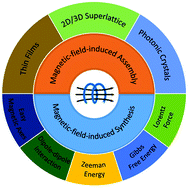Synthesis and assembly of nanomaterials under magnetic fields
Abstract
Traditionally, magnetic field has long been regarded as an important means for studying the magnetic properties of materials. With the development of synthesis and assembly methods, magnetic field, similar to conventional reaction conditions such as temperature, pressure, and surfactant, has been developed as a new parameter for synthesizing and assembling special structures. To date, magnetic fields have been widely employed for materials synthesis and assembly of one-dimensional (1D), two-dimensional (2D) or three-dimensional (3D) aggregates. In this review, we aim to provide a summary on the applications of magnetic fields in this area. Overall, the objectives of this review are: (1) to theoretically discuss several factors that refer to magnetic field effects (MFEs); (2) to review the magnetic-field-induced synthesis of nanomaterials; the 1D structure of various nanomaterials, such as metal oxides/sulfide, metals, alloys, and carbon, will be described in detail. Moreover, the MFEs on spin states of ions, magnetic domain and product phase distribution will be also involved; (3) to review the alignment of carbon nanotubes, assembly of magnetic nanomaterials and photonic crystals with the help of magnetic fields; and (4) to sketch the future opportunities that magnetic fields can face in the area of materials synthesis and assembly.


 Please wait while we load your content...
Please wait while we load your content...